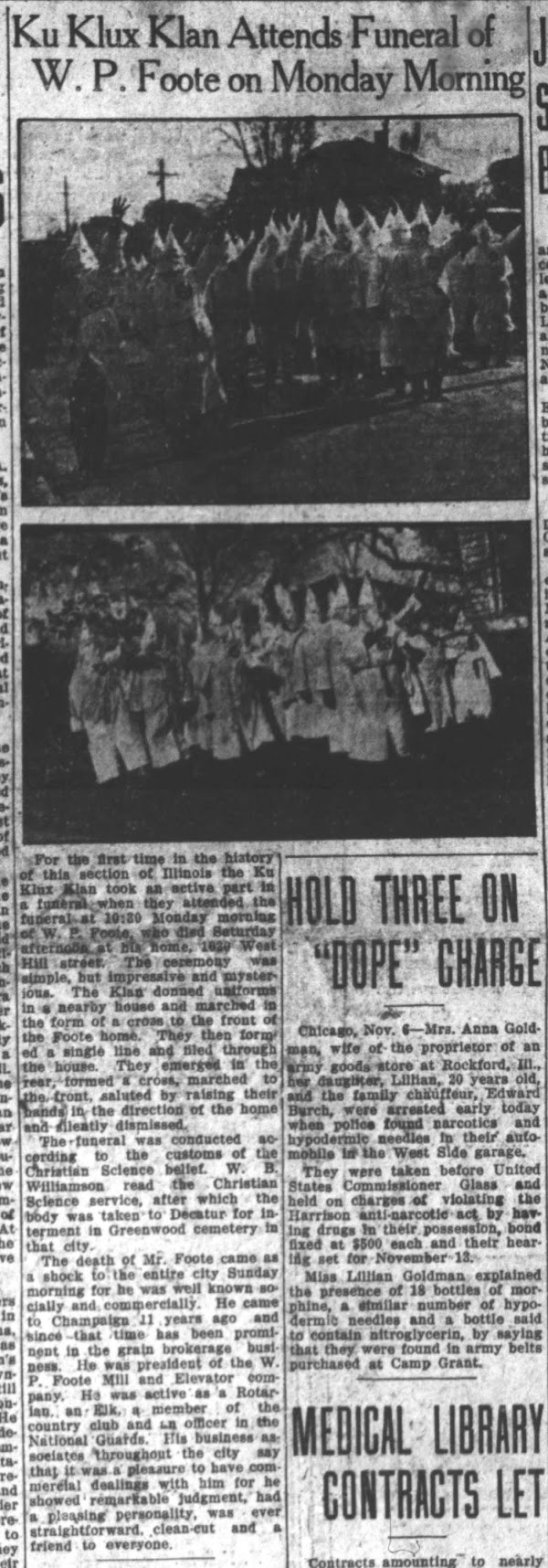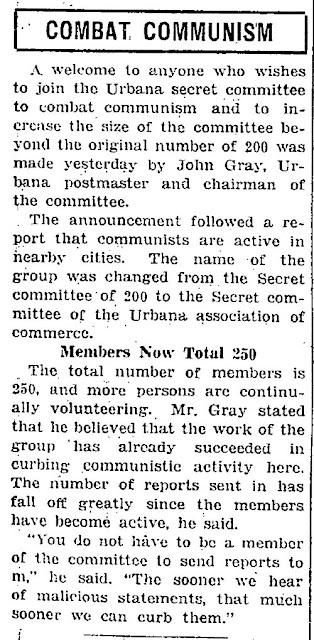 |
| Champaign County's "Exalted Cyclops" and family (Champaign County Historical Archives). |
This research is incomplete, but contains a great deal of dates, clippings, and citations to primary sources available to build off of. Before local Klans burst into public news stories and events, I believe there was a great deal of organizing behind the scenes. Rumors built up until suddenly there were events with hundreds or even thousands of attendees in Champaign County. The Klan popped up in cities and towns large and small throughout the Northern and Midwestern United States in these years.
A look at National and State organizers and individual efforts to grow the organization would be necessary to determine exactly how this happened and who was most responsible locally. I recommend "The Second Coming of the KKK: The Ku Klux Klan of the 1920s and the American Political Tradition" by Linda Gordon. For a local example of regional organizers, please see our page on Reverend McMahan who was key to recruiting and promoting the Klan in Champaign and other counties in Illinois. Chalmer's "Hooded Americanism" talks about the Klan coming to Illinois as well:
The local Klan in Champaign-Urbana was less of a "secret society" than it was an "open secret" society from its first big public appearance. A large gathering and automobile procession starting in Urbana to a massive regional meeting near Mahomet was big news across the area:
Champaign News-Gazette: 8/6/1922 - Klan meeting of 4,000 to 6,000 people.
Urbana Daily Courier: 8/7/1922 - Meeting at Richmond Farm.
Rantoul Weekly Press; 8/9/1922 Meeting coverage (also repeated News-Gazette coverage).
More meetings in the Mahomet area are listed here on the Area Klan page. The second Klan movement was very hierarchal and often operated much like a multi-level marketing organization. Urbana's Zenith Klan No. 56 would become a central hub of activity, dues, robes, and other Klan supplies. It was also a transportation hub to other small towns and Klans and other larger cities and Klan organizations both in Illinois and other States.
Early signs of Klan organization locally were reported in cryptic articles in the local newspapers. Rumors without sources or from the local State's Attorney (it turns out he would know), but few details. From the 10/4/1921 Daily Illini and the 10/27/1921 Urbana Daily Courier:
Some of the earlier hints of Klan interest and activity included advertisements for more information on the Klan in the Urbana Daily Courier, like this one from 2/4/1922:
Benjamin Marcus Bogard, founder and head of the American Baptist Association, was Arkansas’s leading fundamentalist Christian in the 1920s. In 1928, his efforts resulted in a law banning the teaching of evolution in Arkansas public schools; it remained in place until 1968, when the U.S. Supreme Court overturned it.
As our Church and Klan page details, there was a great deal of entanglement between the second Klan movement and certain Protestant churches in the area. This was also generally true throughout the United States in the second Klan movement. Thomas Dixon, Jr., whose novel "The Clansman" inspired new interest and sympathy for the Klan (and later the basis of the popular film "Birth of a Nation") was also a Baptist minister. His brother's claim to fame was writing a series called "The Fundamentals" that heavily inspired and gave rise to the common usage of the "fundamentalist" Christianity in the United States.
The Campus Klan at the University of Illinois emerged in the years after the book "The Clansman" came out. It predated the creation of the second Klan movement that coincided more closely with the release of the film, "Birth of a Nation." This website details the rise of that national movement, started by Simmons, here in Champaign-Urbana and the surrounding areas. The Campus Klan may have had some overlap in membership, but as an organization it was more of a fraternal organization that changed its name and distanced itself from the larger Klan organization. From the Champaign News-Gazette on 4/12/1923:
The name change came on the heals of public cross burnings and other Klan activity detailed below. To what extent the known campus Klan membership may have overlapped with the later local Klan associated with the national organization is still a work in progress.
Going Public in Late 1922:
After the huge 8/5/1922 Klan meeting of thousands from around the region near Mahomet, the next public appearances may have seemed rather tame. A common Klan activity was preforming funeral rites and honors. The first local example of this was for the funeral of Illinois National Guard Captain W. P. Foote. From the News-Gazette on 11/6 and the Daily Illini on 11/7/1922:
The Urbana Daily Courier reported that the next month the Klan also performed part of the funeral ceremony for Frank W. Pittman. From the 12/7/1922 edition:
Later that same month, a local minister got into a dispute with the editor of the Courier over his lectures on sexual promiscuity. The dispute itself had nothing to do with the Klan until the minister, feeling wronged and with no legal recourse argued that the Klan was necessary when the system failed. He did this after the Klan visited his church in full regalia and made a public donation. The Courier, of course, made it front page headline news on 12/18/1922:
The original complaining letter on 12/12, and the 12/18/1922 front page rebuttal letters and editorial on the dispute can be read by clicking the thumbnails below, but they focus on who was complaining versus who penned the complaint letter that was printed in the paper:
The early public visibility of the local Klan in Champaign-Urbana mirrored other area activity. Even down to disputes with local newspaper editors (such as with Rev. Bream and the St. Joseph Record) and using the Klan at churches for implied threats and intimidation (such as with Rev. McMahan out of Mattoon). Compared to the initial headlines of the massive event with representatives from all around the region, the rest of the local Klan's 1922 activities might be best described as small and even awkward. 1923 would start off with an open meeting and end with a massive convention with the Illinois Grand Dragon and national Imperial Wizard. 1923 would also begin a popular new Klan Christmas tradition.
Next post in this series: C-U Klan: Building a Home





















No comments:
Post a Comment